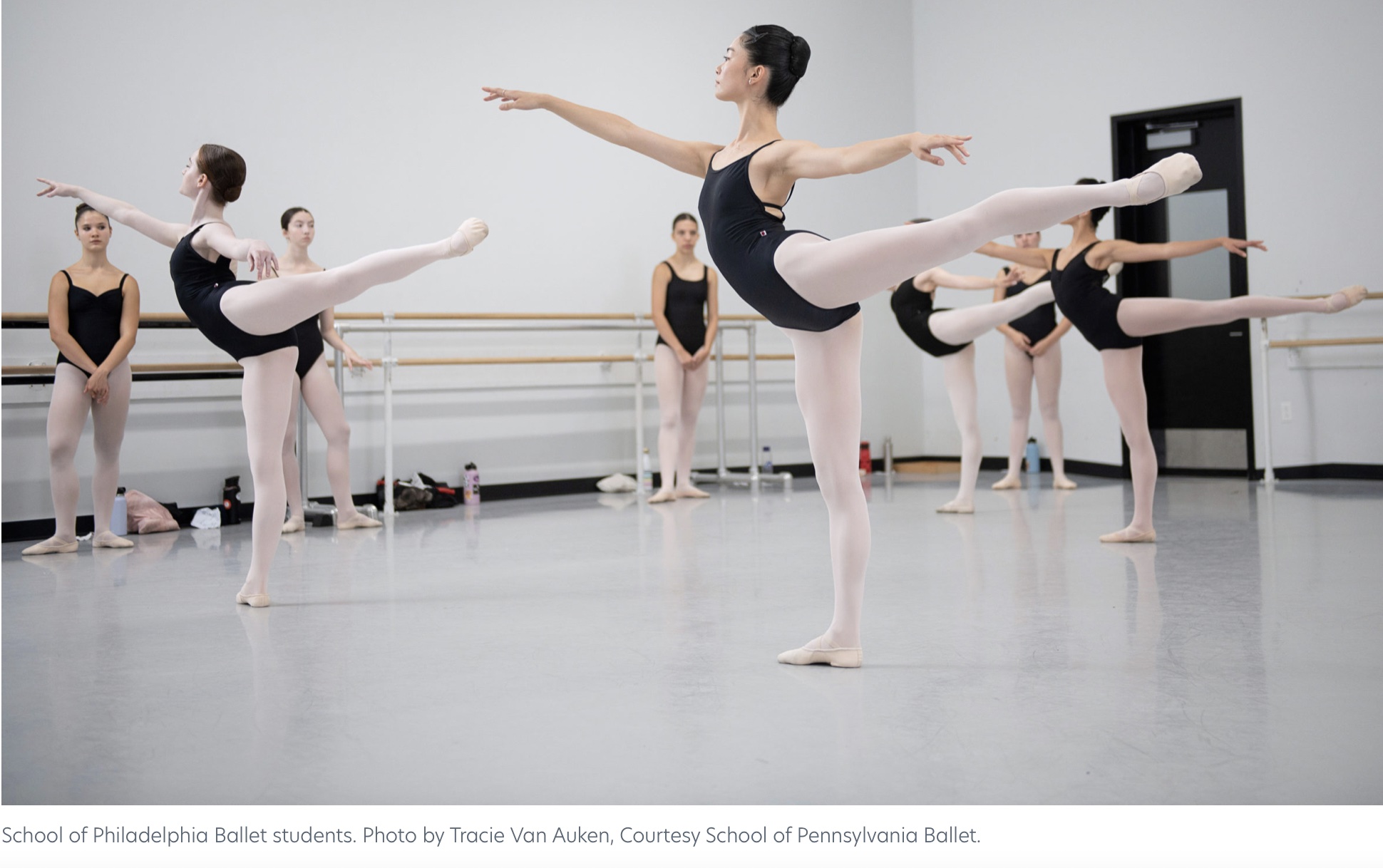
+1 804 221 1273
UNLEARN YOUR FEAR
HOW FEAR WORKS
MOVING PAST FEAR
RELABELING
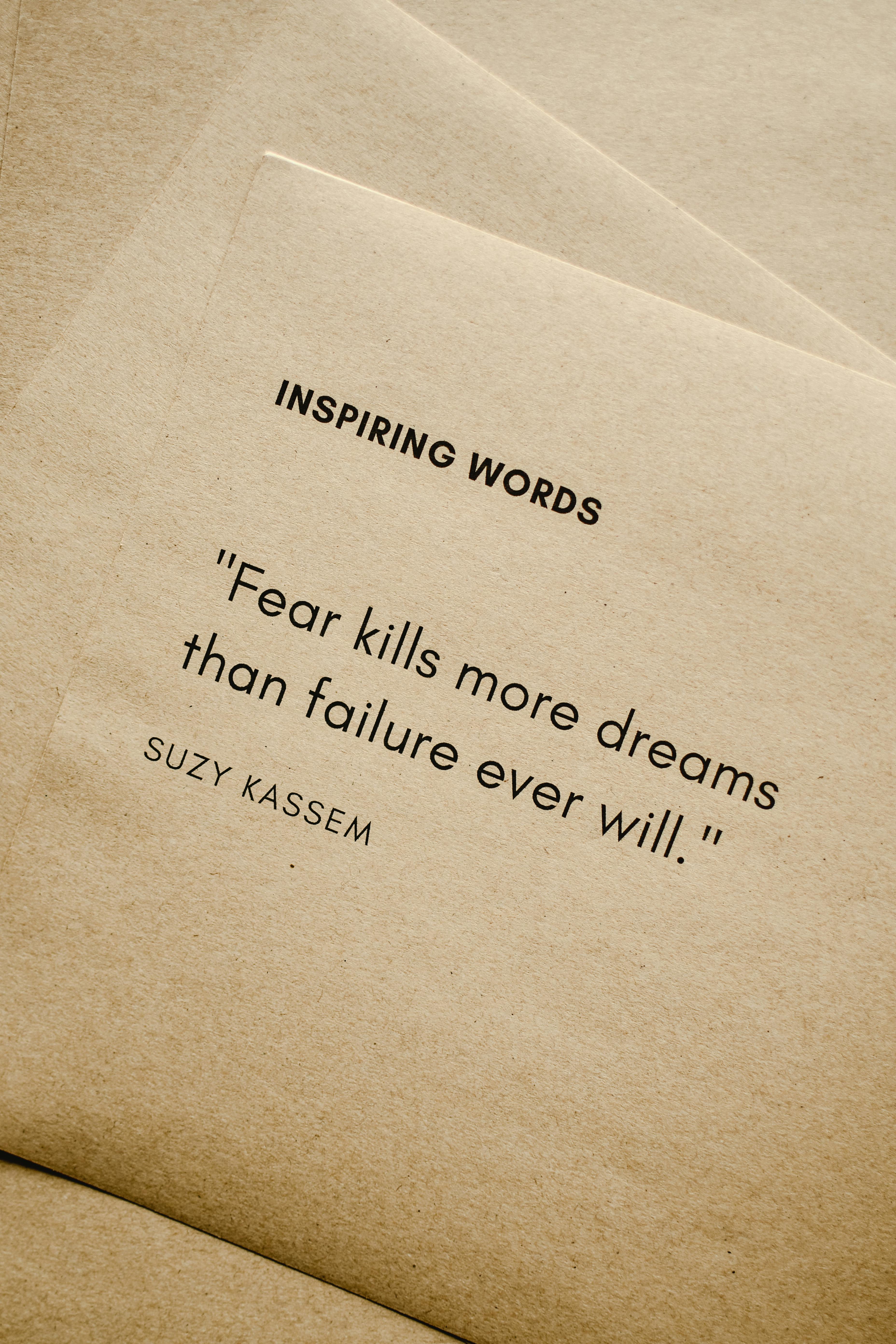
VISUALIZATION
How can visualization be used to overcome fears and phobias? (n.d.). Selfpause.https://selfpause.com/visualization/how-can-visualization-be-used-to-overcome-fears-and-phobias/
Team, NeuroLaunch editorial. “Rewire Your Anxious Brain: Effective Strategies for Lasting Change.”NeuroLaunch.com, 30 Sept. 2024, neurolaunch.com/rewire-your-anxious-brain/. Accessed 30 Jan. 2025.
“The Science of Being Scared: How Your Brain Reacts to Fear - CogniFit Blog: Brain Health News.” CogniFit Blog: Brain Health News, 28 Aug. 2024, blog.cognifit.com/how-your-brain-reacts-to-fear/.
Saab, Linda, and Arash Javanbakht. “What Happens in the Brain When We Feel Fear.” Smithsonian, 27 Oct. 2017, www.smithsonianmag.com/science-nature/what-happens-brain-feel-fear-180966992/.
VIBRATION PLATFORMS
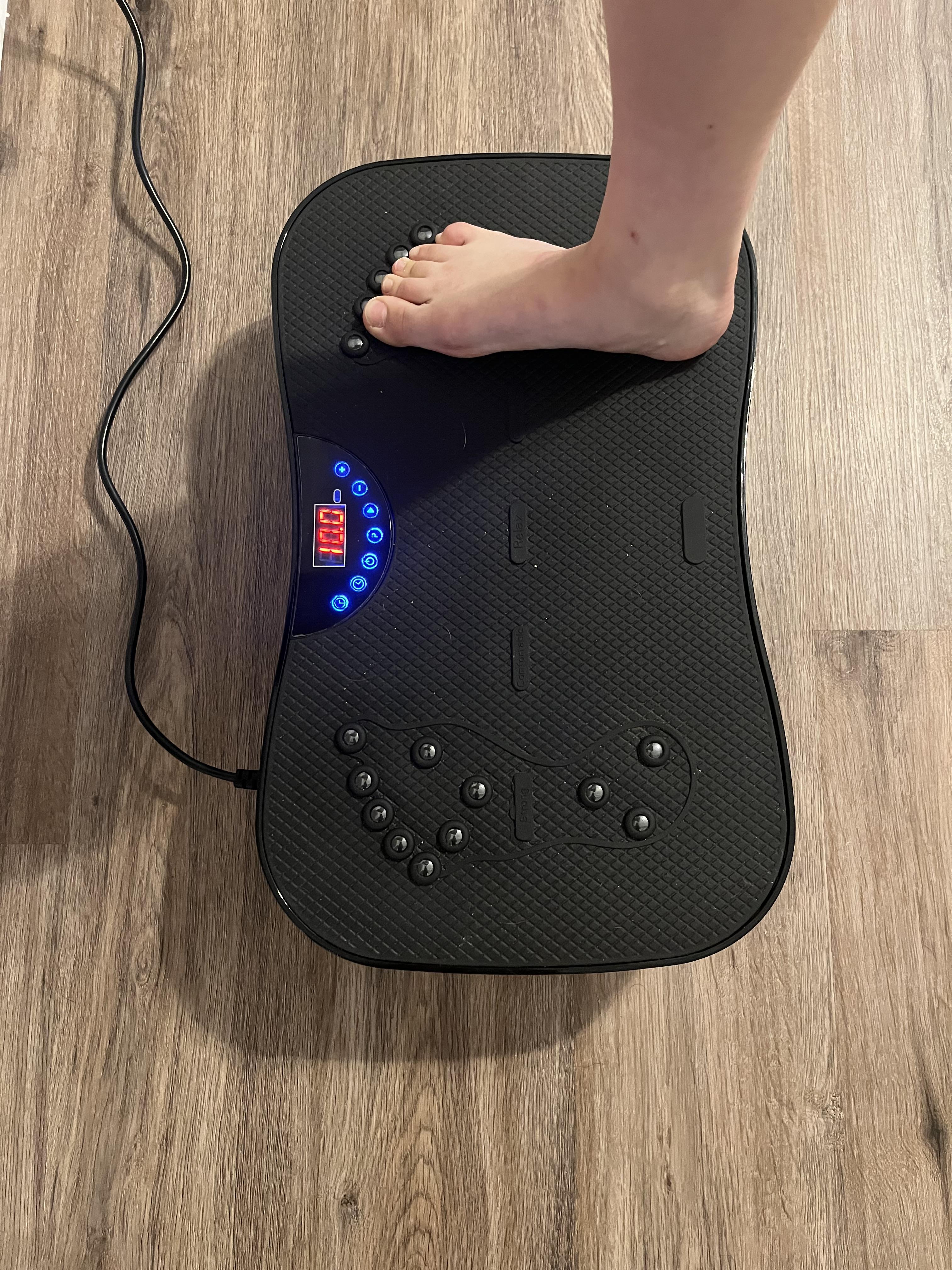
NormaTec Compression
We are pleased to announce we have NormaTec compression technology….. GREAT! But what is it?
What does compression technology do?
Compression technology helps improve proprioception (where the joint is in space), improve blood flow, reduce swelling, decrease the perception of soreness after exercising, decrease the amount of creatine kinase in the blood stream (which is from injury to muscle tissues after intense exercise), and increase oxygen to the muscles.
What are the benefits of the NormaTec system we have in the clinic?
It has a pulsing component to the compression so it more closely mimics the way that muscles pump. It also helps the veins and lymphatic system, which are only equipped with one way valves, to hold pressure and not allow pooling into the lower aspects of the extremities. This is more advanced than regular compression therapy due to its distal release and the gradients it provides. It also means the limb gets rest time between compression cycles which provides more benefits.
Does it Work?
YES! Lactic acid build-up is still not well understood but appears linked to the inflammatory process which allows the creatine kinase release; however, creatine kinase can be decreased with compression technology which assists with improved muscle tissue repair. It also lessens pain sensitivity, can regulate gene expression in muscle tissue, decreases fatigue after exercises, and assists with improved range of motion.
Are there other Benefits?
The compression garments we have in the clinic can assist with injury healing by reducing the inflammation and improving the blood flow. Specific injuries that can be addressed are overuse injuries to tendons and ligaments in addition to muscle strains and sprains.
Who can use it?
Weekend warriors and athletes, persons who stand or sit all day and have poor circulation, pregnant females who wish to reduce the edema in the legs especially once in the 3rd trimester, anyone trying to freshen up their muscles especially if training daily.
Who should not use it?
People with: acute pulmonary edema, acute blood clots, acute congestive heart failure, acute infections, wounds/lesions/infections or tumors, where increased venous and lymphatic return are not desired such as with peripheral vascular disease, bone fractures or dislocations near the site.
Should I just rely on the boots?
No. Active recovery is still the best recovery and there are many factors involved in achieving optimal performance. What are some examples of active recovery? Interval training like jumping jacks for a minute and then walking for 2 minutes and repeating this task. On rest days you can also use active recovery like walking or swimming to help decrease overtraining as long as it is only at 30-60% of your max heart rate. Nutrition, sleep, and stretching are also important parts of your recovery process.
Arts and Athletics is committed to keeping you living your life without limits so come in today to get started on your journey to feeling better and training harder!
NUTRITION
March is National Nutrition Month® and part of any great recovery or success in sport at an elite level requires adequate nutrition. Muscles depend on protein to rebuild and become stronger after an injury. An under fueled elite athlete could struggle with injury, fatigue, soreness and trouble advancing in their sport. Caring for the whole patient is our number one goal at Arts and Athletics Physical Therapy which is why we are pleased to announce a partnership with Nutrition Aligned and Sarah Atlas, RD.

Emily has known Sarah for nearly a decade and Sarah has personal insights into both recovery nutrition (post-op and post injury) and nutrition for elite athletes, as well as being an expert in her field and evidence based in her practice.
Although physically located in Nevada, Sarah is able to offer tele-health care.
For more information please visit Nutrition Aligned's website.
Emily has also purchased a series of infographics from Nutrition Aligned designed specifically for Arts and Athletics to help answer basic questions on anti-inflammatory foods, RED-S, sample snacks and meal options to make sure your body is working optimally to help you live life without limits.
WOMEN IN SPORTS
The first week of February marks
According to Women’s Sports Foundation females tend to drop out of sports by age 14, which is 2x higher than their male counterparts, but research has shown that participating in sports has many benefits. As we have discussed in prior blogs, being active helps with mental health, decreases risk for developing chronic diseases due to a sedentary lifestyle, increases confidence and improves self-image further illustrating why participation in a sport can be life changing.
Another hurdle any athlete faces, but also females in a disproportionate amount, is injury. Females face challenges of increased injury risk during their period with researchers finding that the risk is not random and peaks during the first two days after the onset of menses and during ovulation (or days 1-6 when estradiol and progesterone are at their lowest). This makes the chance of major injury more likely. Recent research from Smith et al reviewed a wide body of literature and found that female athletes are at a 4-10x higher risk for developing ACL injuries due to these hormonal fluctuations than their male counterparts.
With all the limitations that could impact girls and women in sports, Arts and Athletics Physical Therapy wants to empower you to live life without limits. Whether you need help with strength, injury prevention, easing back into a sport or fitness routine we are here for you and understand your unique needs as an athlete. Please reach out to schedule a free assessment so we can take whatever is holding you back and use it as a steppingstone to get where you want to be!
IMPROVE YOUR BALANCE
Having good balance is one of the keys to preventing injury.
Grab some ideas on exercises to integrate into your classwork/warmup from this Dance Magazine article about balance that we were honored to be a part of.
It's a quick read and provides easy tips for ANYONE to start working on to improve their balance!

NUTCRACKER SURVIVAL GUIDE!
Most dancers in the middle of - or about to - start the annual Nutcracker season. With the excitement of the holidays, the colder weather, and longer period of dance it's important that dancers have tools to keep them performing at their best. Here are some tips, tricks, and reminders to keep you from "crackin'" with our:
DIABETES
November is Diabetes Awareness Month- How Does Diabetes Impact Your Musculoskeletal Health?
DID YOU KNOW? With diabetes certain musculoskeletal conditions are more prevalent like frozen shoulder, carpal tunnel syndrome, and even arthritis. Physical activity is considered one of the three cornerstones for the management of diabetes due to its generally low cost, and ability to promote aerobic and cardiovascular benefits. In addition, it appears that exercise can lower A1C over time which can decrease the risk of diabetic complications.
Diet, medications, and exercise are the hallmark treatments for Type II Diabetes. Research indicates favorable disease reversal in persons with Type II Diabetes who can lose weight since it can eliminate fat in the pancreas. Sometimes people with diabetes cannot tolerate corticosteroids or other pain-relieving medications due to their impact on blood sugars which can make exercise hard since joint pain can be a common finding in this population. In fact, medications used to treat common comorbidities in Type II diabetics and even those patients without Diabetes can often end up hospitalized with combinations of these medications due to their effects on blood sugars. Pharmacist Salum Mkata provides this list below:
Beta Blockers
Calcium Channel Blockers
Dilantin
Thyroid Hormones
Older versions of Oral Contraceptives
Diuretics
Niacin
Minoxidil
Corticosteroids
So, where do you turn if you have joint pain and Diabetes and are looking for pain control, safe exercise, and ways to decrease your other medications to help with symptom management? Physical therapy is a great resource as we can assist with mobility, provide exercises to help with safe joint loading, weight loss and countless other ways to improve your daily life. Please make your appointment today and let Arts and Athletics Physical Therapy help you live your life without limits.
REFERENCE MATERIAL: Smith LL, Burnet SP, McNeil JD - Musculoskeletal manifestations of diabetes mellitus - British Journal of Sports Medicine 2003;37:30-35.
DEPRESSION
Depression impacts about 280 million people across the world. Many people who have depression often go undiagnosed due to the variety of ways it can present in different individuals, the overlapping of symptoms with other co-morbidities and the way depression can fluctuate (such as seasonal depression). Although activity may seem like the last thing people suffering from depression want to do, the encouraging news is that even just a bit of exercise can help with symptom management. You don’t even have to complete the exercise all at once. Accumulating little bits of exercise throughout your day can benefit both your physical and mental health. So how does exercise help? It increases circulation to the brain in addition to providing a sense of accomplishment by becoming stronger or increasing a sense of well-being.
Looking at 15 studies researchers found that about 12% of depression cases could be prevented with exercise. Brisk walking for 2.5 hours a week had a lower risk for depression than people who did not exercise at all. Research also supports that you can get by with half of the amount of exercise you need for your physical health; however, there is something to be said by too much of a good thing since benefits do not appear to increase for exercise above the recommended physical activity guidelines. Too much exercise can manifest as burnout in athletes and teens and mimic depression.
Regular exercise equates to decreased symptoms of depression. Not sure where to start or how to start? Please contact Arts and Athletics Physical Therapy today. We can help you establish a program that works for you and helps you feel safe, empowered and able to better tackle your day to day activities.
Kim, J. H. (2022). Regular physical exercise and its association with depression: A population-based study short title: Exercise and depression. Psychiatry Research. https://doi.org/March 2022
Murez, C. (2022). Exercise is Powerful Medicine for Depression. U.S. News and World Report. https://www.usnews.com/news/health-news/articles/2022-04/13/exercise-is-powerful-medicine-for-depression
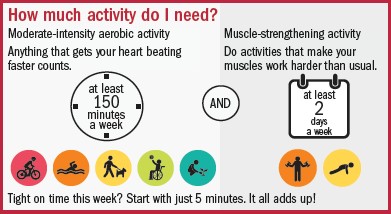
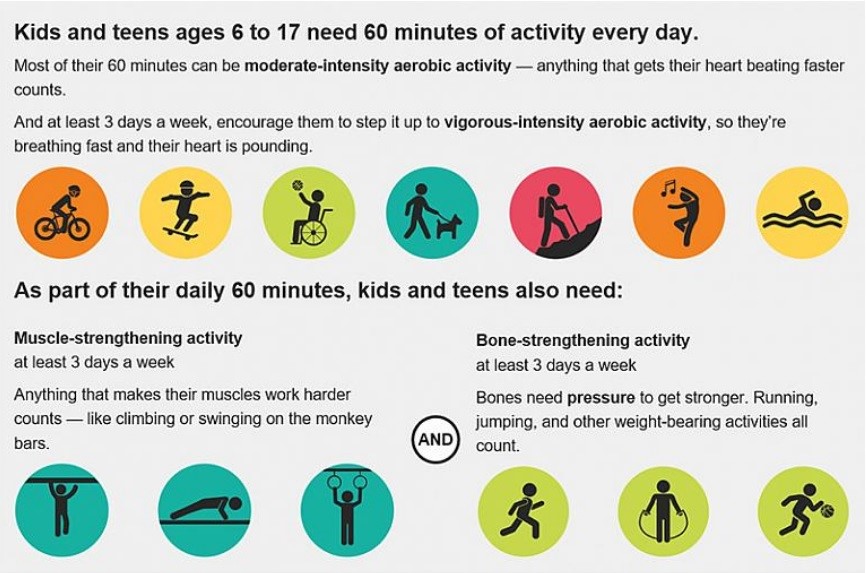
Activity guidelines from the CDC are 150 minutes of moderate intensity aerobic activity a week. Some examples are walking your dog, swimming, biking, mowing the yard. The second component of recommended exercise is strength work 2 or more days a week that work all the major muscle groups- legs, hips, back, chest, shoulders, core, and arms. Some examples are lifting weights, using resistance bands, planks, push-ups, digging and shoveling. Here is an infographic from the CDC for kids and teens and adults
HOW TO RETURN TO SPORT the S.A.F.E. way
RETURN TO SPORT
Whether you have been sidelined due to an injury, illness or just taking a much-needed rest break from your sport, there can still be some questions about how to safely get back in the game. While taking a break can reduce burn out and risk for injury, it can be equally challenging thinking about how to get back into the game. With school having started, here are some tips to help you be ready for return to sport with the easy to remember acronym SAFE.
"S"
Start slowly. UC Davis Health recommends that if you are still moderately fit you start back at 50% of your prior activity level every other day, or 3 times a week. If you are doing well with that after your first week you can increase your duration or how hard you are working by 10% each week. Remember to make slight changes one at a time. So, do not increase your weight, add more distance to your run, or even change your shoes all at the same time.
"A"
Add Goals - Make some SMART goals. Those should be specific and realistic as well attainable. This will help you stay motivated and allow you to continue to progress with your training. Start with some specific to your sport or activity. An example would be, I will complete the same number of heel raises on each foot in 30 seconds to demonstrate I have improved lower leg strength to help with my running, jumping, and overall strength.
"F"
Find a friend. Finding a friend helps motivate you to continue your course, and you can help each other make sure you are not overdoing it. A friend can also help remind you that your goals are attainable and to be patient with yourself as getting back to your sport takes time and persistence. Some days are harder than others and a good friend can help by listening and encouraging you to keep persevering.
"E"
Eliminate comparison – Remember everyone is different and develops at various times. Some people may bounce back quicker than others. You could have had a growth spurt which can change your muscle length tension and endurance. Someone else may have been more active over the break. Remember to take things at your own pace and listen to your body.
SOURCES CITED
Waite, Brandee. “Browse Topic: Rehabilitation: News: UC Davis Health.” Browse Topic: Rehabilitation | News | UC Davis Health, 10 Jan. 2022, https://health.ucdavis.edu/news/topic/rehabilitation.
